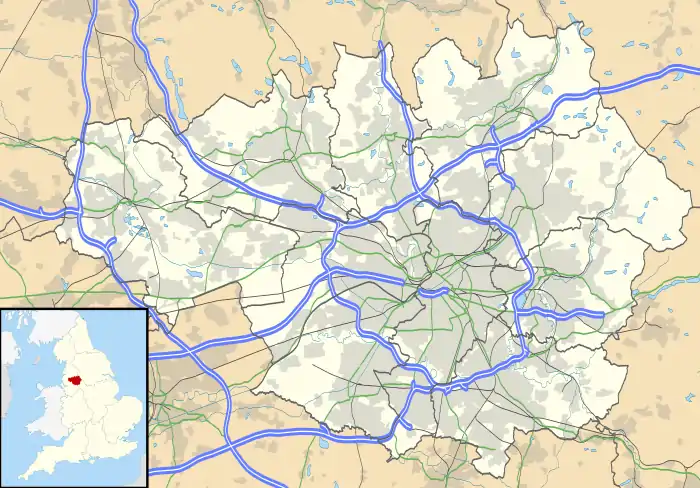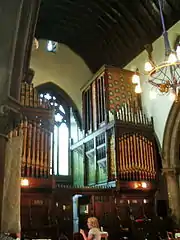St Peter's Church, Hindley
St Peter's Church is in Atherton Road, Hindley, Wigan, Greater Manchester, England. It is an active Anglican parish church in the deanery of Wigan, the archdeaconry of Warrington, and the diocese of Liverpool.[1] St Peter's is recorded in the National Heritage List for England as a designated Grade II listed building.[2]
| St Peter's Church, Hindley | |
|---|---|
 St Peter's Church, Hindley | |
 St Peter's Church, Hindley Location in Greater Manchester | |
| OS grid reference | SD 616,042 |
| Location | Hindley, Wigan, Greater Manchester |
| Country | England |
| Denomination | Anglican |
| Website | St Peter, Hindley |
| History | |
| Status | Parish church |
| Dedication | Saint Peter |
| Architecture | |
| Functional status | Active |
| Heritage designation | Grade II |
| Designated | 10 May 1988 |
| Architect(s) | E. G. Paley |
| Architectural type | Church |
| Style | Gothic Revival |
| Groundbreaking | 1863 |
| Completed | 1866 |
| Specifications | |
| Materials | Rock-faced stone with ashlar dressings Slate roof |
| Administration | |
| Parish | St Peter, Hindley |
| Deanery | Wigan |
| Archdeaconry | Warrington |
| Diocese | Liverpool |
| Province | York |
| Clergy | |
| Rector | Canon Revd. Margaret.J.Sherwin |
| Curate(s) | Revd. George Taylor |
| Laity | |
| Director of music | Pat Davies |
| Churchwarden(s) | Lindsey Yates, Fred Allen |
| Music group(s) | Church Factor |
History
The church was built in 1863–66 and designed by the Lancaster architect E. G. Paley.[3] It cost £9,507 (equivalent to £890,000 in 2019),[4] and provided seating for 689 people.[5]
Architecture
Exterior
St Peter's is constructed in rock-faced stone with ashlar dressings and has a slate roof. Its plan consists of a five-bay nave with a clerestory, north and south aisles, a chancel with a southwest vestry, north and south porches, and a northeast tower with a broach spire. The tower has diagonal buttresses, a stair turret to the east, and a three-light north window. The bell openings are paired, each having two lights and louvres. At the top of the tower is a cornice and gargoyles. The spire has two tiers of lucarnes, the lower tier having two lights. Along the walls of the aisles are two-light windows containing Geometric tracery. Between the windows are buttresses with gables, the cornices of which are carved with animals. Along the clerestory are pairs of two-light windows. At the west end of the nave is a four-light window flanked by gabled buttresses. There are two-light windows at the west ends of the aisles. The east window has three lights, and is also flanked by gabled buttresses. In the south wall of the chancel is a two-light window with a trefoil head.[2]
Interior

The arcades are carried on round piers with crocketted capitals. The wagon roof is supported by separate corbelled shafts. In the church are two wrought iron chandeliers. The font is round and is carried on a quatrefoil column. Its bowl is carved with roundels.[2] The stained glass includes a window dated 1881 to the memory of a nine-year-old child; it incorporates his photograph twice. The organ is at the west end.[3] It has three manuals and was made by Edmund Schulze in 1873.[6] It was rebuilt in 1903 with pneumatic action by Thomas Pendlebury of Leigh.[7] In 1966 J. H. Cowen of Liverpool added a detached electric console and more stops.[8] In 1977 most of the alterations made by Cowan were reversed by the Pendlebury Organ Company of Cleveleys, who also added a new detached drawstop console. The organ has been awarded a Historic Organ Certificate, Grade II*. This organ is no longer in a playable condition, and the church currently uses a digital computing organ built by Hugh Banton in 2004.[9] There is a ring of eight bells, all cast in 1866 by Mears and Stainbank of the Whitechapel Bell Foundry.[10]
See also
References
- St Peter, Hindley, Church of England, retrieved 6 June 2011
- Historic England, "Church of St Peter, Wigan (1287248)", National Heritage List for England, retrieved 7 June 2012
- Pollard, Richard; Pevsner, Nikolaus (2006), Lancashire: Liverpool and the South-West, The Buildings of England, New Haven and London: Yale University Press, p. 198, ISBN 0-300-10910-5
- UK Retail Price Index inflation figures are based on data from Clark, Gregory (2017), "The Annual RPI and Average Earnings for Britain, 1209 to Present (New Series)", MeasuringWorth, retrieved 2 February 2020
- Brandwood, Geoff; Austin, Tim; Hughes, John; Price, James (2012), The Architecture of Sharpe, Paley and Austin, Swindon: English Heritage, p. 220, ISBN 978-1-84802-049-8
- "NPOR N10905", National Pipe Organ Register, British Institute of Organ Studies, retrieved 2 July 2020
- "NPOR N10906", National Pipe Organ Register, British Institute of Organ Studies, retrieved 2 July 2020
- "NPOR N01709", National Pipe Organ Register, British Institute of Organ Studies, retrieved 2 July 2020
- "NPOR R00463", National Pipe Organ Register, British Institute of Organ Studies, retrieved 2 July 2020
- S Peter, Hindley, Dove's Guide for Church Bell Ringers, retrieved 6 June 2011